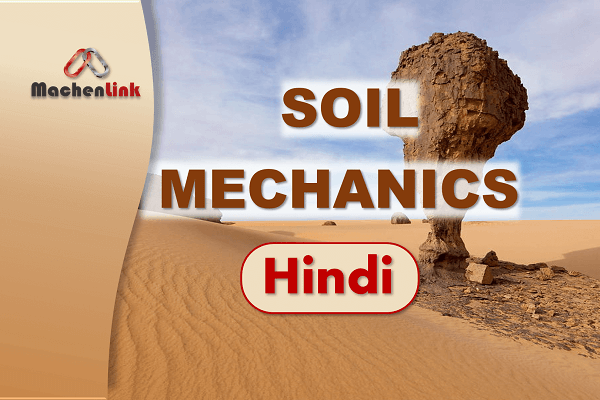
Soil Mechanics
13 modules
Hindi
Access for 90 days
Overview
"If a builder builds a house for a man and does not make its construction firm, and the house which he has built collapses and causes the death of the owner of the house, that builder shall be put to death."
The Code of Hammurabi, Babylon, Circa 2000 B.C.
"2600 People die every year due to Building collapse."
Disaster Management of India
Engineering is, foremost, about solving the real problems not only questions in your exams.
Soil - (for Civil Engineers) an uncemented aggregate of mineral grains and decayed organic matter (solid particles) with liquid and gas in the empty spaces between the solid particles.
Soil Mechanics - is the branch of science that deals with the study of the physical properties of soil and the behaviour of soil masses subjected to various types of forces.
Soils Engineering - is the application of the principles of soil mechanics to practical problems.
Geotechnical Engineering is the subdiscipline of civil engineering that involves natural materials found close to the surface of the earth. It includes the application
of the principles of soil mechanics and rock mechanics to the design of foundations, retaining structures, and earth structures.
KEY FEATURES
- Topics are taught thoroughly and systematically to clarify the basic concepts and fundamental principles without weakening technical hardship.
- Many example problems are solved to demonstrate or to provide further insights into the basic concepts and applications of fundamental principles.
- The solution of each example is preceded by a strategy, which is intended to teach students to think about possible solutions to a problem before they begin to solve it. Each solution provides a step-by-step procedure to guide the student in problem-solving which really help students for university examinations and for the conventional exam like ESE (Engineering Services Examinations).
THE GOAL OF THIS COURSE,...
- To understand the physical and mechanical properties of soils.
- To determine parameters from soil testing to characterize soil properties, soil strength, and soil deformations.
- To apply the principles of soil mechanics to analyze and design simple geotechnical systems.
LEARNING OUTCOMES
When you complete this video course you should be able to:
- Describe soils and determine their physical characteristics such as grain size, water content, and void ratio.
- Classify soils.
- Determine compaction of soils.
- Understand the importance of soil investigations and be able to plan a soil investigation.
- Understand the concept of effective stress.
- Determine total and effective stresses and porewater pressures.
- Determine soil permeability.
- Understand the effects of seepage on the stability of structures.
- Determine how surface stresses are distributed within a soil mass.
- Specify, conduct, and interpret soil tests to characterize soils.
- Understand the stress-strain behaviour of soils.
- Understand popular failure criteria for soils and their limitations.
- Determine soil strength and deformation parameters from soil tests, for example, Young’s modulus,
- friction angle, and undrained shear strength.
- Discriminate between “drained” and “undrained” conditions.
Modules
Course Overview
Introduction to Soil Mechanics
1 attachment • 24.99 mins
01 Introduction to Soil Mechanics
Basic Definitions and Relationships
4 attachments • 2 hrs
02 Three Phase Diagram and Basic Definitions
03 Relationships between soil constituents with Examples
04 Determine Water Content and Specific Gravity
05 Determine Unit Weight
Index Properties
6 attachments • 3 hrs
06 Sieve and Sedimentation Analysis
07 Pipette and Hydrometer Method
08 Particles Size Distribution Curve
09 Determination of Liquid Limit and Plastic Limit
10 Determination of Shrinkage Limit and Shrinkage Parameters
11 Activity, Sensitivity and Thixotropy of Clay
Soil Classification
2 attachments • 1 hrs
12 Textural and Highway Research Board Classification
13 Unified Soil Classification System (USCS)
Soil Structure and Clay Mineralogy
1 attachment • 24.99 mins
14 Soil Structure and Clay Mineralogy
Permeability and Well Hydraulics
7 attachments • 3 hrs
15 Basic of Permeability
16 Laboratory Test of Permeability
17 Indirect Method of Permeability, Flow Parallel and Normal to Soil Layers
18 Factors Affecting Permeability
19 Introduction to Well Hydraulics
20 Pumping Out Permeability Test
21 Pumping In Permeability Test
Seepage Analysis
6 attachments • 3 hrs
22 Seepage Pressure and Laplace Equation
23 Flow Net
24 Determination of Seepage Discharge
25 Seepage through Non-homogeneous Soils and Earth Dams
26 Seepage through Earth Dams With Example
27 Filter Design
Stress-Strain and Effective Stress
5 attachments • 3 hrs
28 Stress-Strain and Modulus of Elasticity of Soil
29 Principle of Effective Stress
30 Effect of Water Table Fluctuation on Effective Stress
31 Effect of Surcharge and Capillary Rise in Soil
32 Effect of Seepage
Stress Distribution in Soil
4 attachments • 2 hrs
33 Principal Stresses
34 Vertical Stresses due to Point Load
35 Vertical Stresses due to Line Load, Strip Load, Embankment Load and Circular Load
36 Rectangular Load and Newmark's Influence Chart
Compaction of Soil
2 attachments
37 Compaction of Soil Part 1
38 Compaction of Soil Part 2
Compressibility and Consolidation
2 attachments
Consolidation Part 1
Consolidation Part 2
Shear Strength
8 attachments • 54.24 mins
Shear Strength 1
Shear Strength 3
Shear Strength 4
Shear Strength 5
Shear Strength 6
Shear Strength 7
Shear Strength 8
Shear Strength 9
Rate this Course
₹ 999.00
Order ID:
This course is in your library
What are you waiting for? It’s time to start learning!

Wait up!
We see you’re already enrolled in this course till Access for 90 days. Do you still wish to enroll again?
